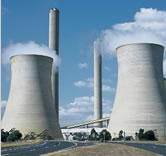Nov 12 2008
WWF has welcomed the International Energy Agency's call for an 'energy revolution' when the inter-governmental organisation presented its new World Energy Outlook in London today.
 WWF shares IEA’s view that the use of coal is the biggest threat to the world’s climate © WWF-Canon / Tanya PETERSEN
WWF shares IEA’s view that the use of coal is the biggest threat to the world’s climate © WWF-Canon / Tanya PETERSEN
WWF shares IEA’s view that the use of coal is the biggest threat to the world’s climate. The new report predicts that if governments fail to put into place the right policies and measures, coal use will grow by at least two per cent per annum until 2030 - much more than the other conventional fuels.
“What concerns us is that the IEA fails to call for an end to ’business-as-usual’ coal,” said Dr Stephan Singer, Director of WWF’s Global Energy Program. “For WWF, any policy to contain dangerous climate change must stipulate that only very low-carbon and pollution emitting coal energy sources are being deployed.”
An alternative climate-compatible scenario, included in the IEA outlook for the first time, aims at keeping atmospheric CO2 concentration at the safer 450ppm level, costing about $US 9 trillion more than business as usual over the next 25 years but yielding enormous pay-back in saved energy costs.
“We do share the view of the IEA that an energy revolution is needed,” said Dr Singer. “Yet the IEA assumes an oil price of US$100 – 120 per barrel between now and 2030. This is much too low, does not take account of increasingly depleted oil resources and will never trigger that energy revolution.”
“IEA's climate friendly scenario is truly ambitious compared to earlier IEA scenarios, but underestimates what is required. It sets the bar too low by talking about achieving an almost 40% CO2 reduction by the OECD by 2030 based on 2006 levels. What we need is more: a 25-40 per cent reduction over 1990 levels already in 2020.”
WWF shares the IEA analysis that most of new investments in the energy sector between now and 2030 must and will go into the power sector – approximately $US 17 trillion in IEA’s low carbon scenario.
“That sounds a lot of cash. But it’s only around 0.5% of global GDP which is far less than the price of inaction in form of the much higher costs of damaging impacts of climate change.”
“Also, the various non-climate benefits such as reduced air pollution, new market opportunities for clean technologies, and saved money from energy bills are not included in this calculation.”
The IEA's 450 ppm scenario shows a 40% share of renewables in the global power sector by 2030 and about 350 GW of capacity under carbon capture and storage – an essential but still largely uncosted technology set to become part of the price of using coal.
“Governments have shown that they have a pivotal role in regulating the financial markets,” said Dr Singer. “They need to assume a similar role in relation to energy markets and their emissions into the atmosphere.”